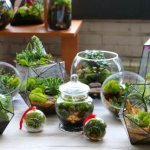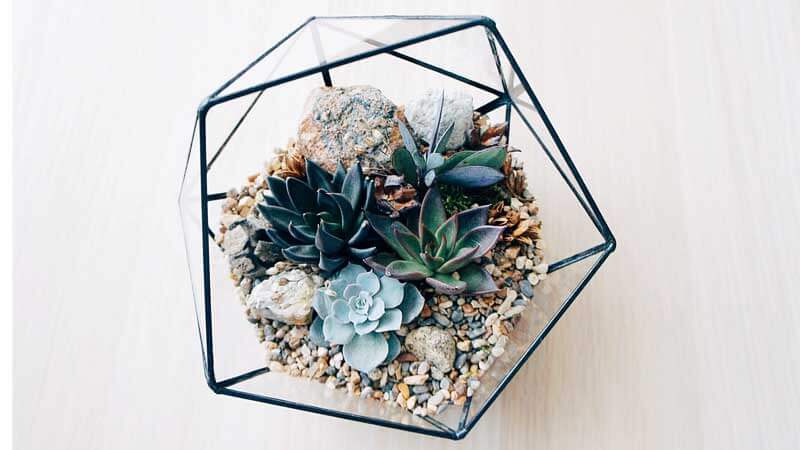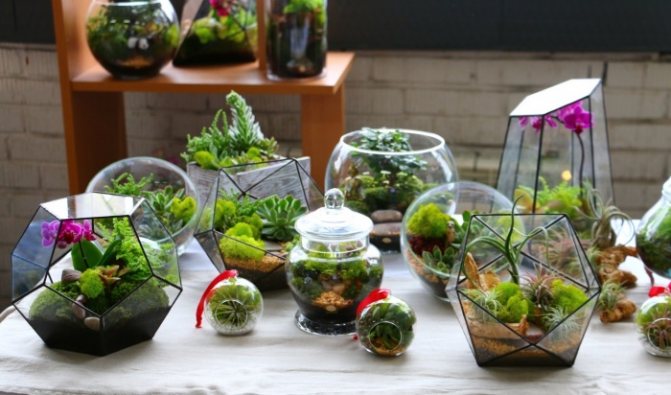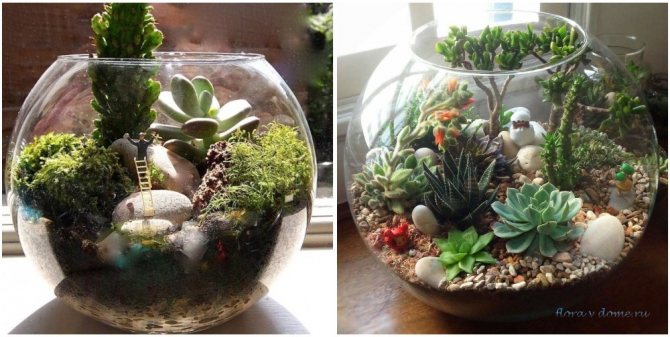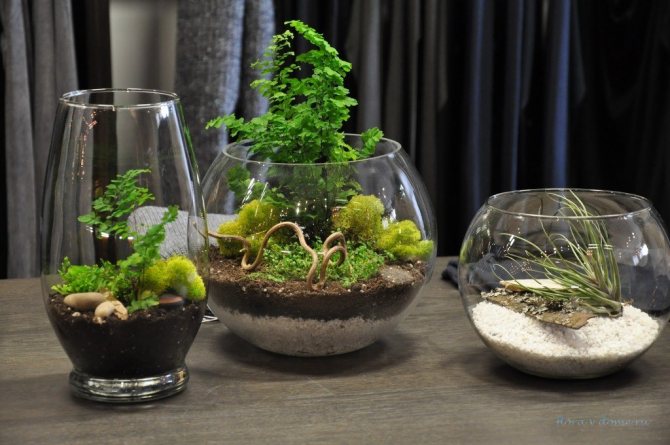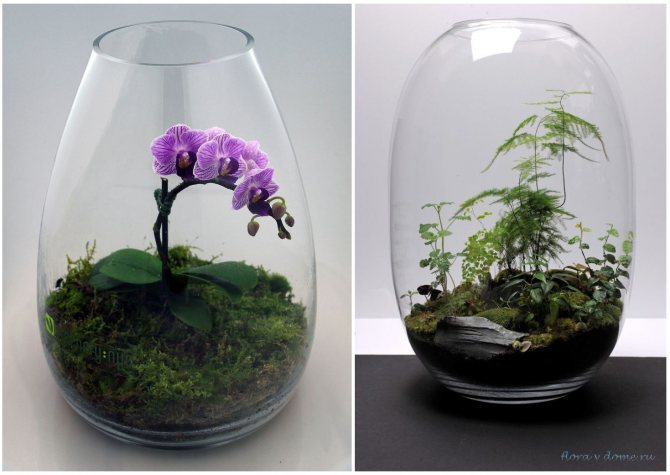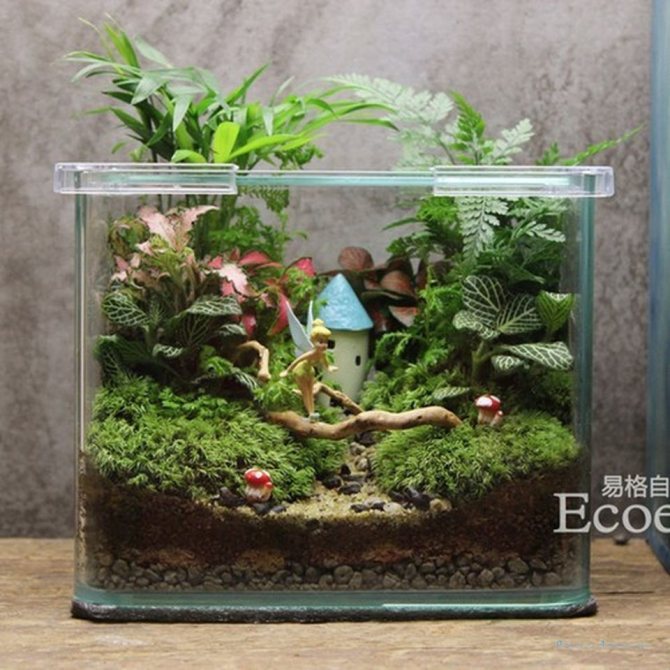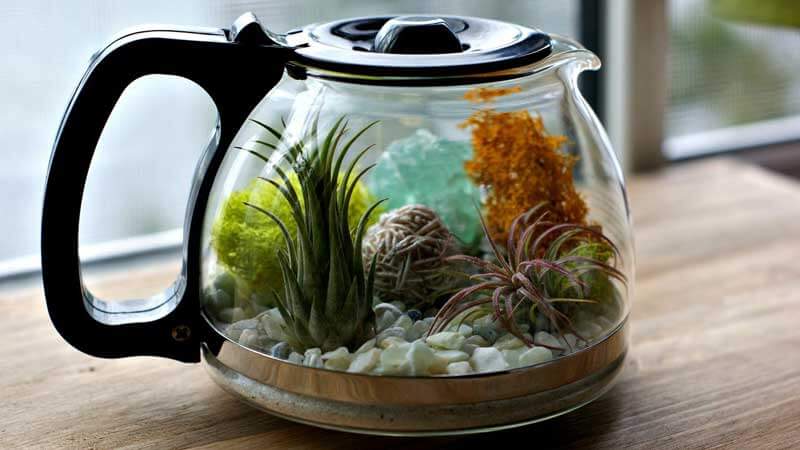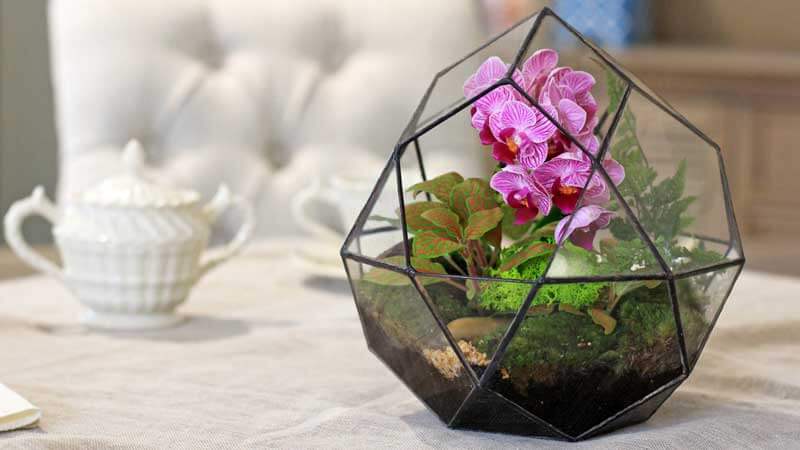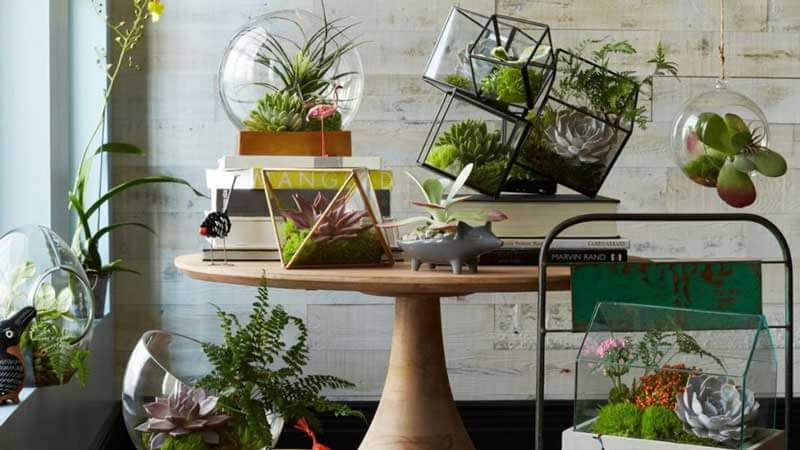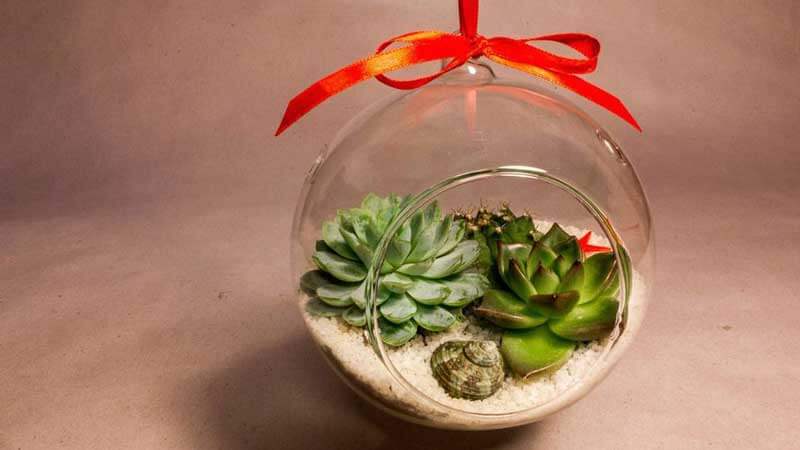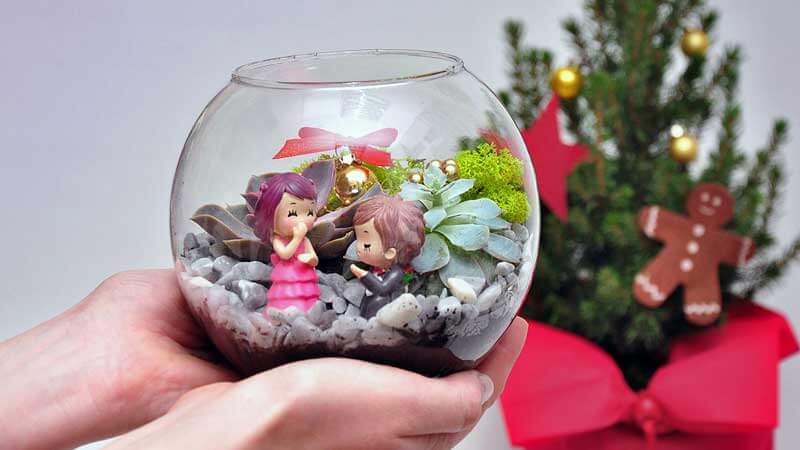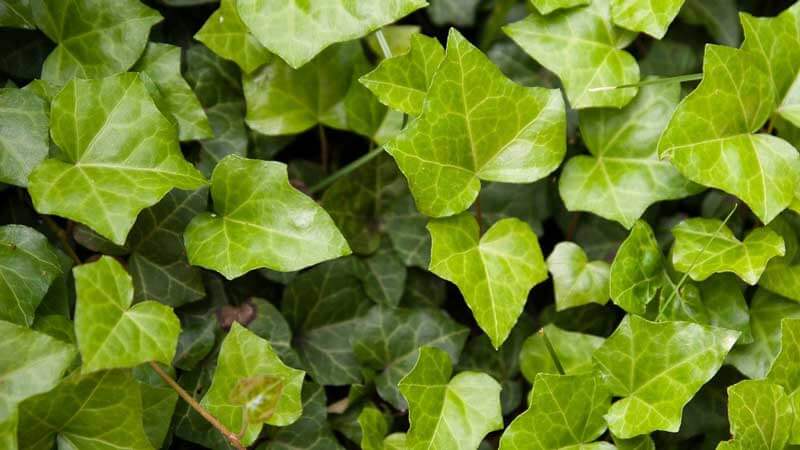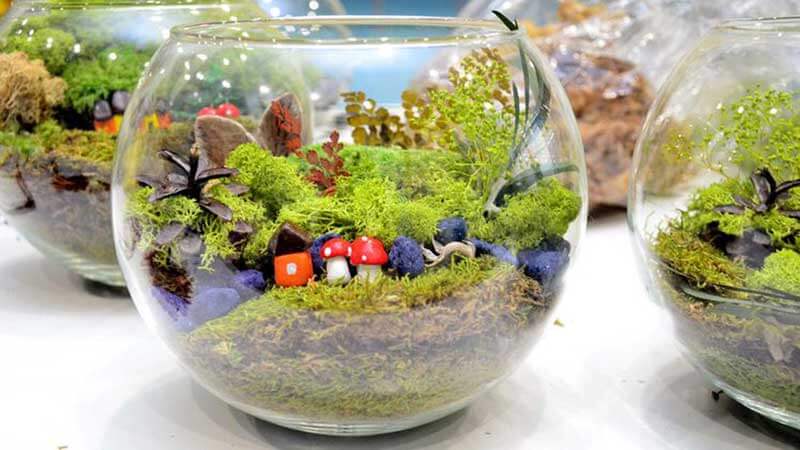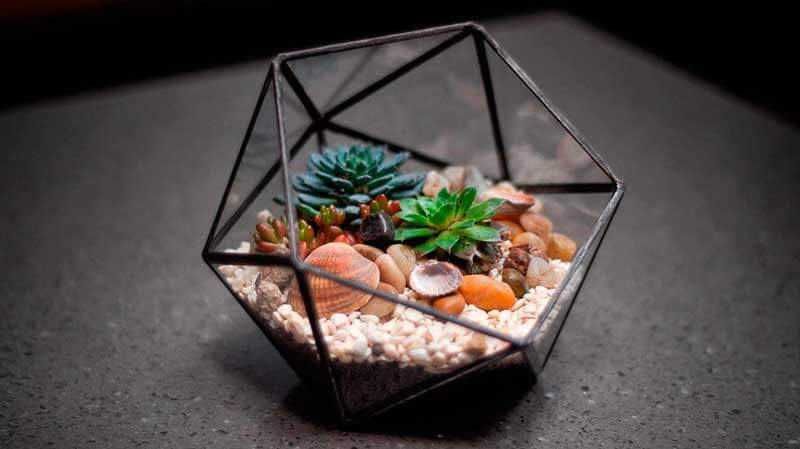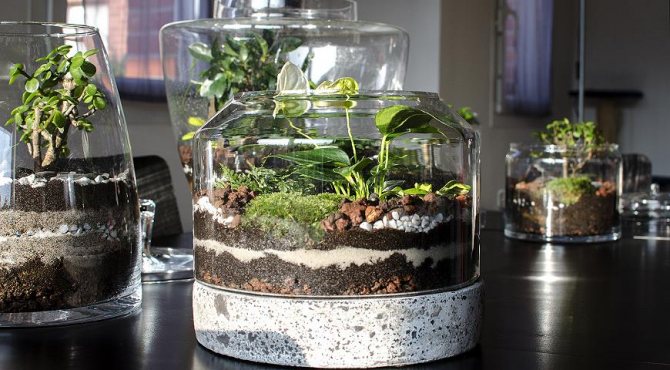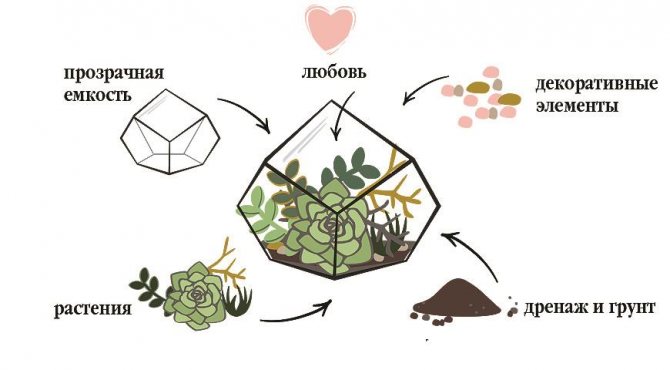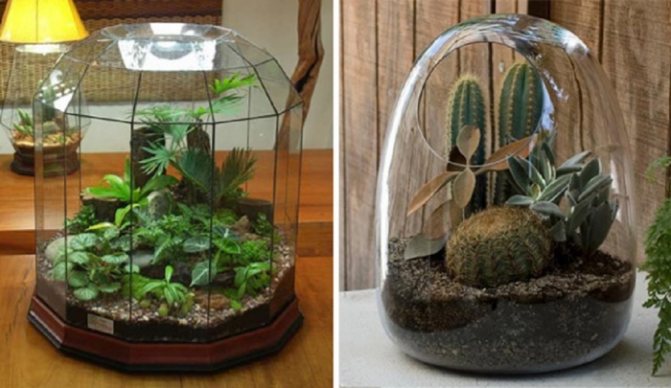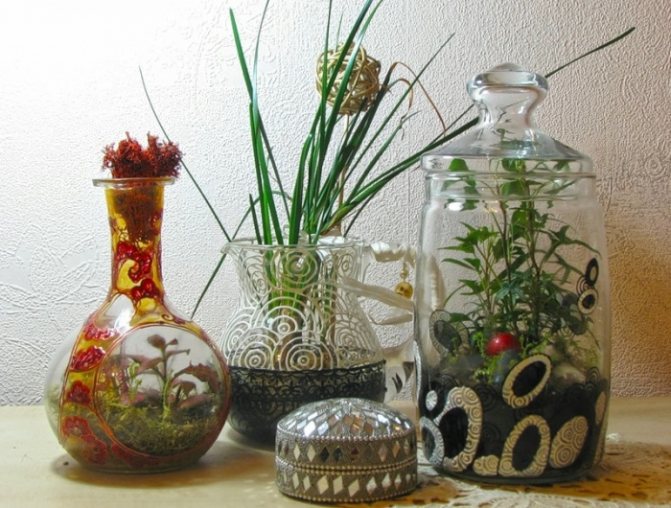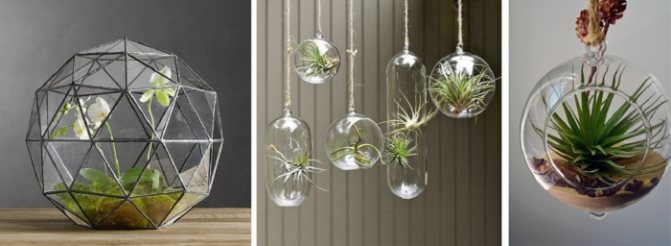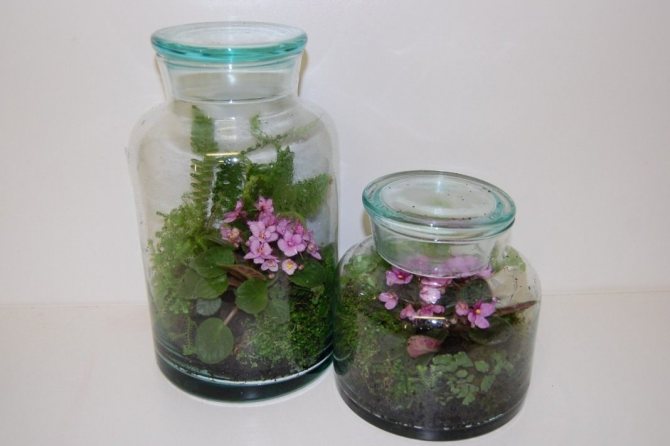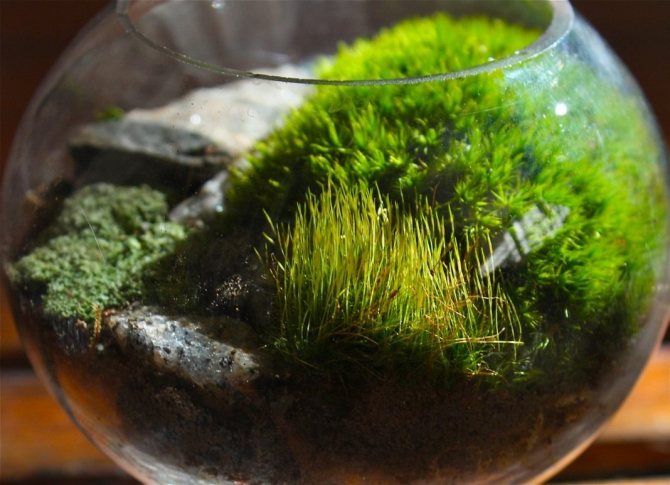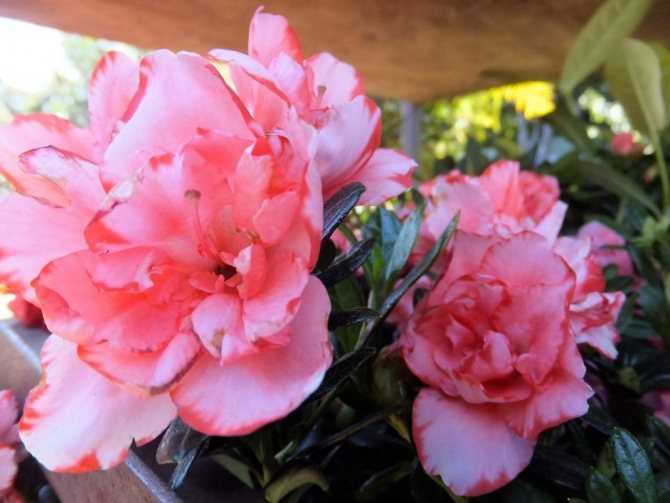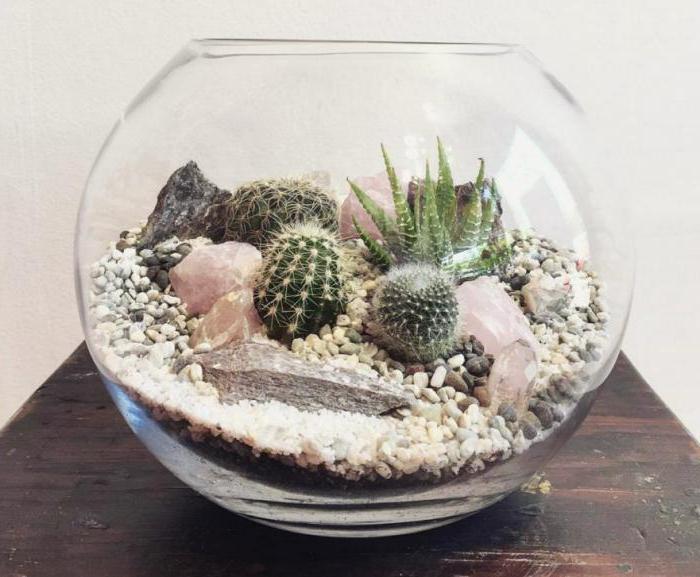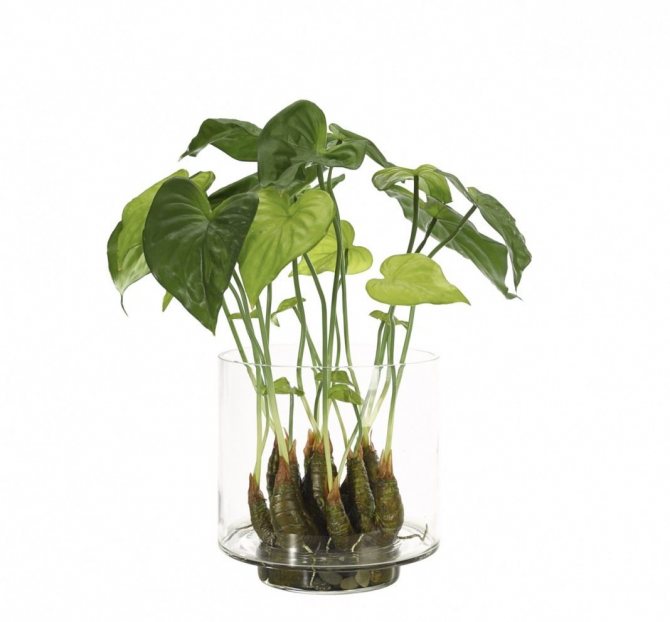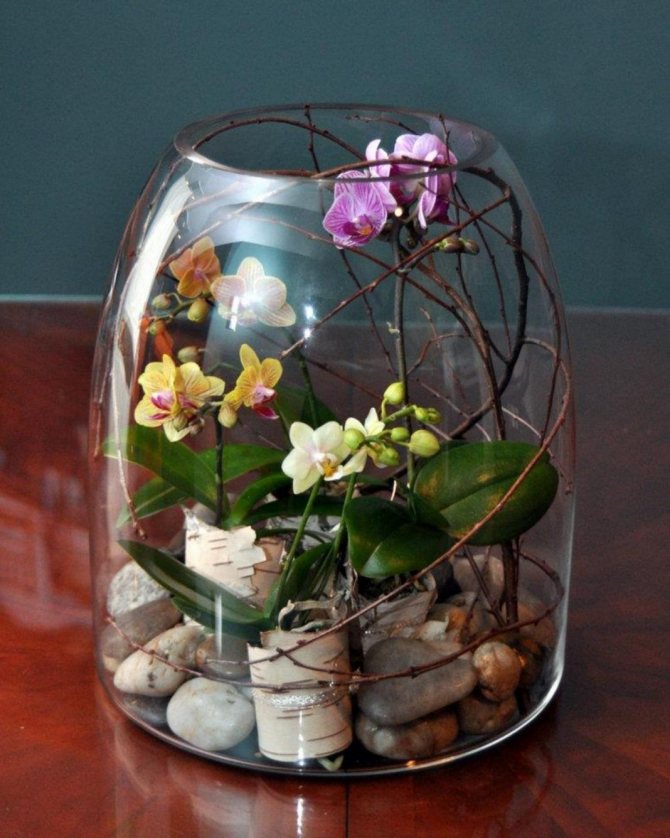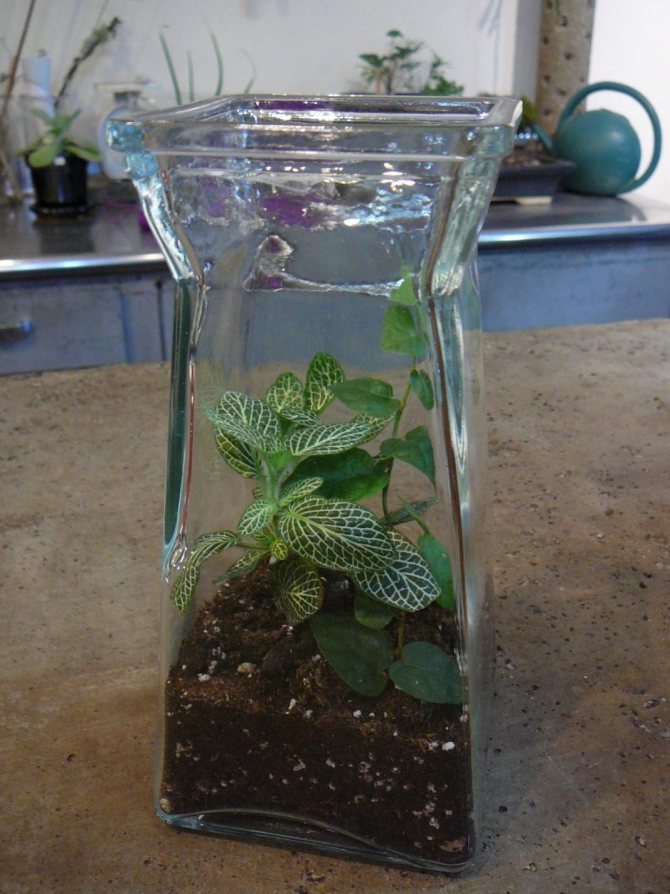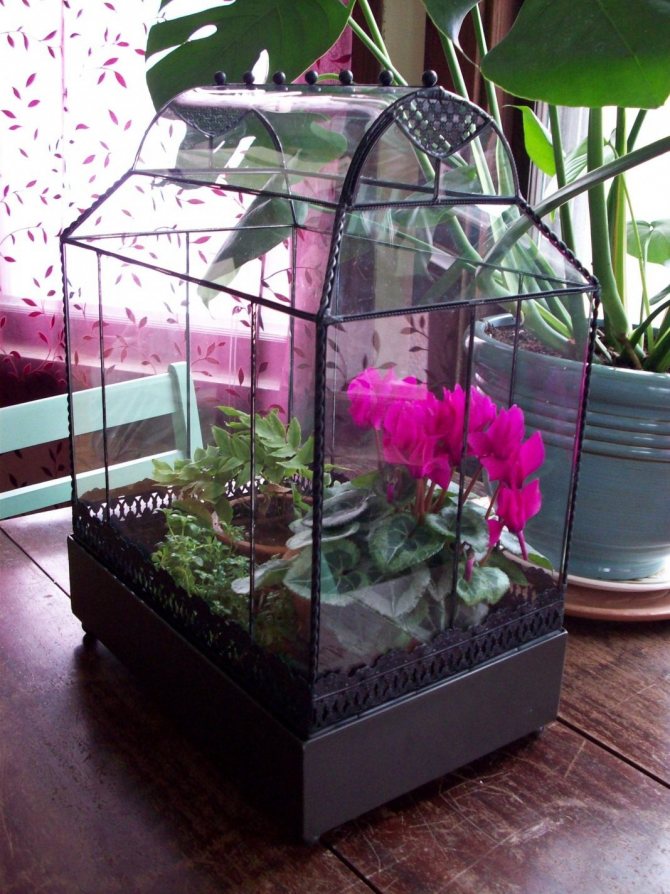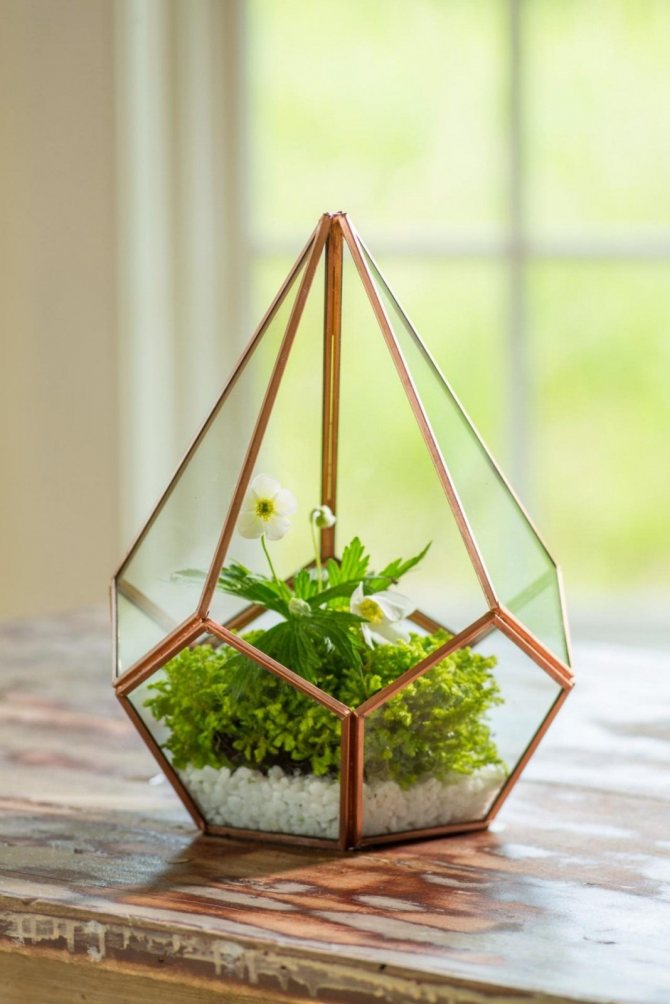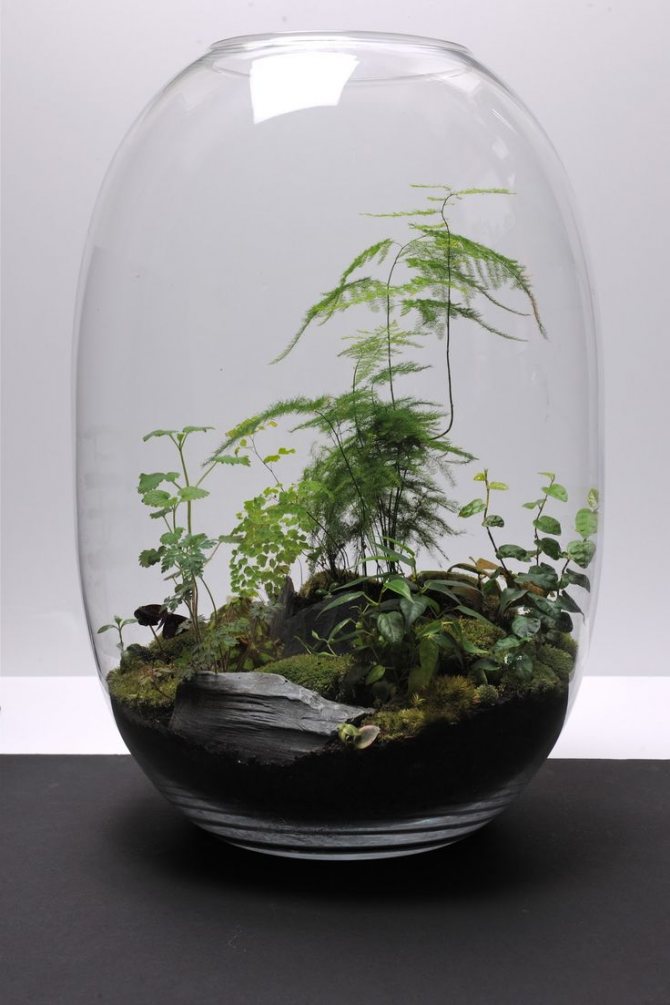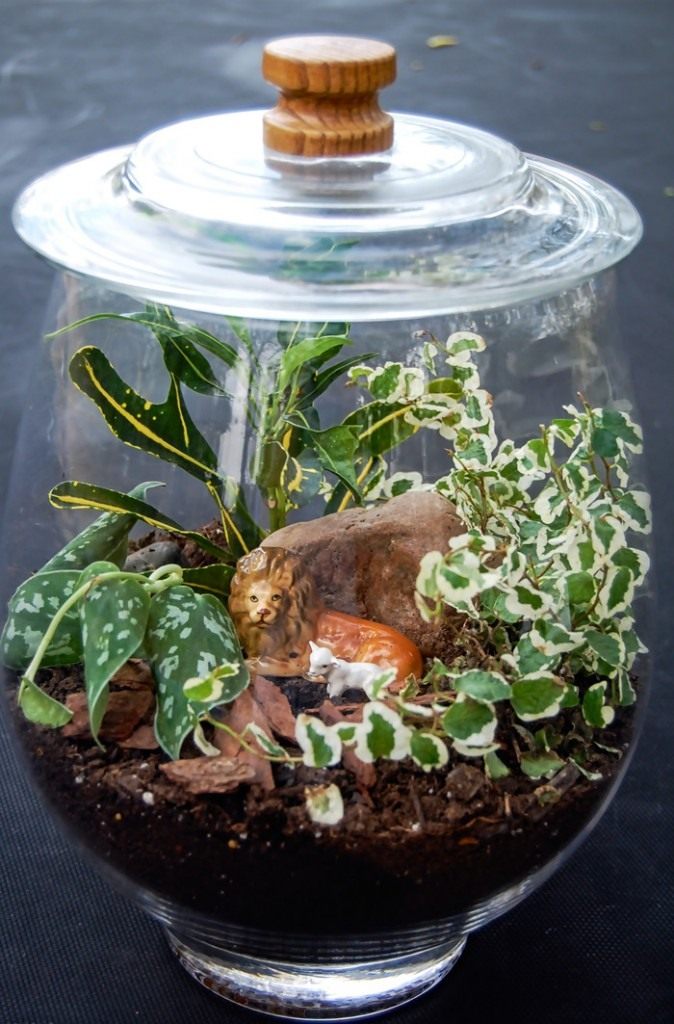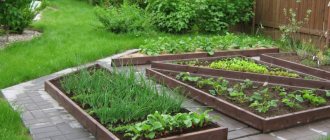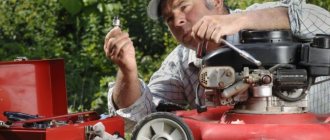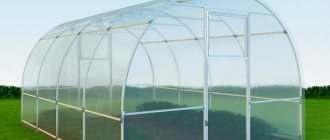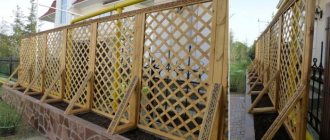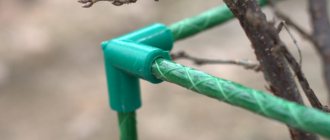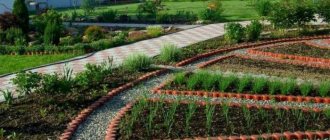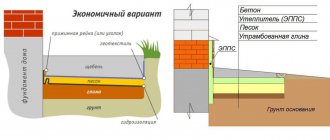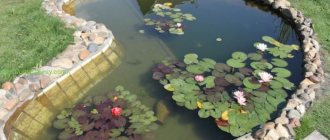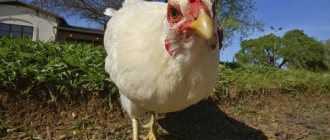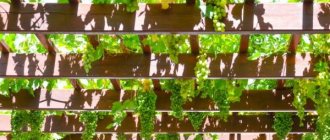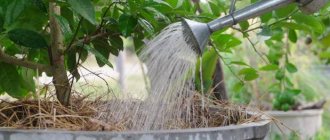DIY beauty deserves admiration and long-term admiration. This unspoken rule and such a wonderful craft as the florarium does not bypass. It can be purchased ready-made, but for those who like to create true beauty on their own, it is recommended to do it yourself.
In this case, it is necessary to heed the useful advice of the wizards who can help solve the problem in the process. So, how to make a florarium with your own hands, a master class and some expert advice.
How to choose plants for a florarium
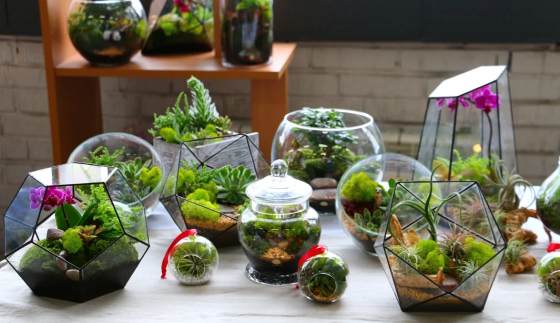
The choice of plants for the florarium entirely depends on your preferences, imagination and plans. First, decide on the ecosystem you want to create. Desert, tropics or hillsides - what landscape do you want to reproduce?
Once the terrain is selected, learn all about the soil typical of this type of terrain. Make sure you can fully meet the quality characteristics of the soil. And only after that start gardening.
General criteria for selection
For the florarium, low-growing small plants with slow growth are selected. This will seem strange to many growers, but the soil for them should not be too nutritious in order to prevent rapid growth. And many, on the contrary, do everything to create the best conditions for their pets.
Therefore, the florarium is a good option for those who, due to their employment, cannot devote much time to caring for flowers. The rest will have to slightly reduce their "zeal" in this sense. But what exactly is worth spending your time on is creating a composition. It is necessary to think over: what plants to choose, what will become the semantic center.
The following arrangement of plants in the florarium looks most advantageous: in the center - the tallest, then - the middle ones, and the shortest - closer to the edges.
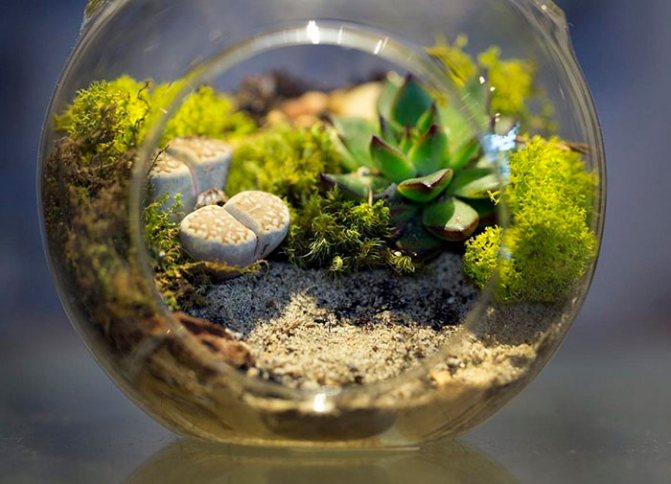

Choose plants with similar care requirements
What should first of all be paid attention to when choosing:
- for what purposes the composition is created;
- plants should be medium to small in size;
- their slow growth;
- similar care conditions.
Suitable plants for the composition can be found, for example, in the forest (moss, fern); purchased in indoor flower shops, and even in pet stores - for decorating terrariums, aquariums, etc.
Advice. If the plants for the florarium are chosen "wild", then they must be treated with disinfectants. This can be a wash with a weak manganese solution. But still, this does not guarantee complete neutralization, and there is a risk of infecting other flowers with diseases and pests.
Plants for tropical florariums
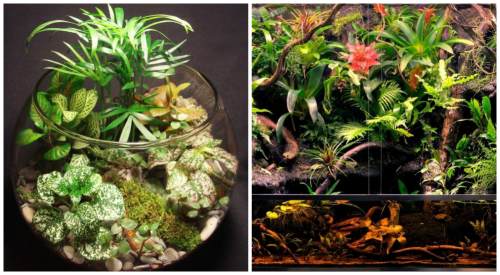

The tropics are perhaps the most difficult type of ecological environment. A high level of humidity must be maintained at all times along with the supply of light for at least 12 hours. In addition, the presence or absence of air flow plays an important role. A large-scale tropical landscape can only be maintained with the installation of a climate control system. But miniature gardens will also require vigilant attention.
The most spectacular inhabitants of indoor tropics:
- indoor fern,
- crotons,
- moss,
- fittonia.
Desert florarium
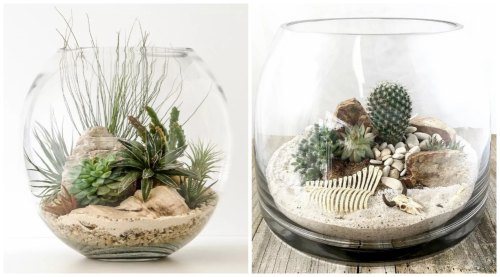

Phytodesigners recommend starting with mini greenhouses, in which the most unpretentious plants are involved.When we talk about the simplest florarium, of course we are talking about the inhabitants of the desert.
Pay attention to the quality: it must be clean coarse sea sand. Small stones, roots, shells of different sizes will add color.
Which representatives of the desert are suitable for modeling a mini-landscape:
- cactus,
- aloe,
- agave,
- echeveria,
- Haworthia.
Plants suitable for composition
When choosing flora for a florarium composition, you should adhere to the following recommendations:
- The limited space forces the selection of plants with a slow growth rate. The rapid increase in size will necessitate regular pruning of shoots, and this is a very time-consuming and inconvenient process. Advice! Pre-shortening of the root system slows down plant growth.
- The maximum plant height is 20 cm.
- When decorating a closed florarium, the composition is made up of moisture-loving flora representatives that tolerate high humidity well.
- When completing, take into account similar conditions of detention.
Here are several design options for original compositions.
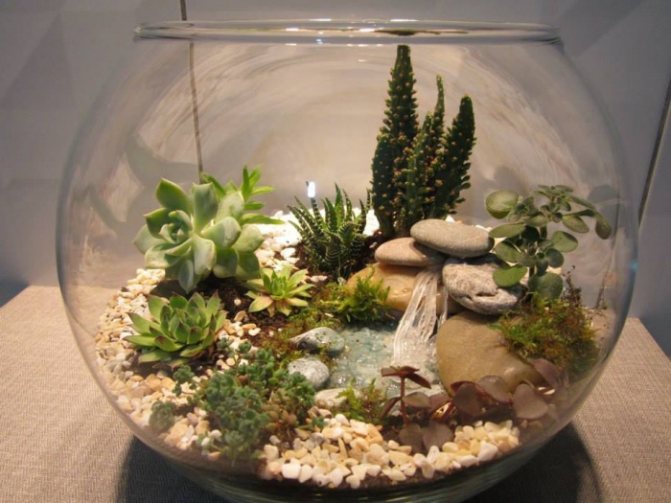

Desert or rocky landscape in a dry florarium. Succulents in the form of agave, saxifrage and jerky are best suited for its formation. Unpretentious plants are able to withstand the inexperience of beginners.
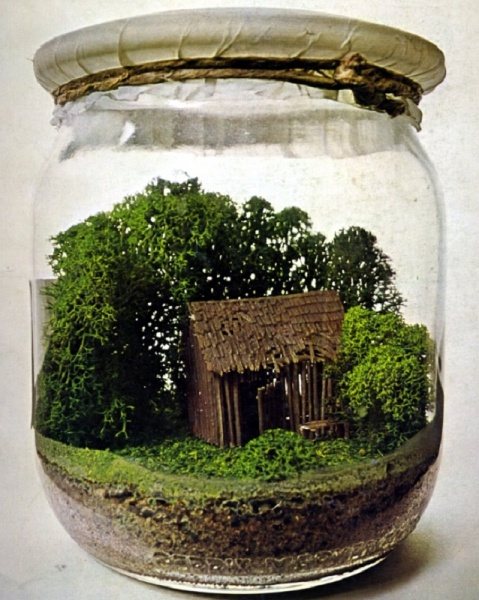

Those wishing to have a corner of the rainforest in the apartment should think about the design of a wet florarium. For these purposes, choose:
- compact bushes of tradescantia and begonias, which need regular pruning due to their active growth;
- fittonia and pilea;
- chlorophytum, which is periodically renewed with fresh shoots;
- moss in the form of sphagnum;
- ferns: pteris, asplenium and mnogoryadnik.
Blooming compositions look extremely attractive, among them florariums with orchids deserve special attention, the arrangement of which is within the power of experienced flower growers.
Attention! The ventilation system, additional heating and lighting are the necessary conditions for maintaining the vitality of the florarium, where orchids are used as decoration.


In addition to the beauties of orchids, azalea, cyclamen, gusmania, saintpaulia are suitable for the formation of a magnificently blooming composition. The bouquet of plants with extraordinary foliage colors will harmoniously dilute: begonia, crotons, fittonia and alocasia.
Various compositions for the design of florariums are presented below in the photo:
Forest miniature
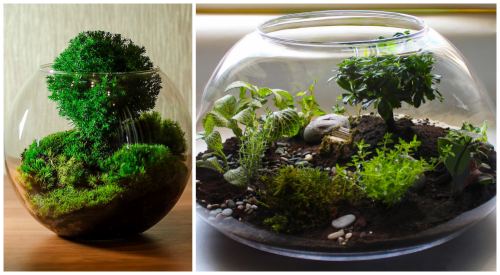

Forest miniature is the second after the tropics in terms of the complexity of execution and maintenance of the microclimate. The main problem is the root system of forest flora, which requires a large amount of land with a rather complex composition. It is simply impossible to keep all the proportions perfectly.
In addition, the forest is the forest - strife: the bushes of the middle zone are unlikely to get along with the moss from Siberia. Even peat should fit the general design.
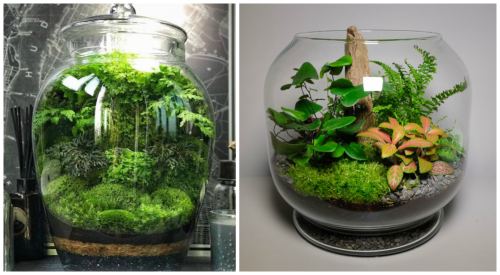

But all of the above does not mean that we must abandon this luxurious idea:
- Use special fertilizers for top dressing and neutral soil.
- Disinfect the soil with phytosporin and activated carbon more often.
- Replace rotten wood parts in time.
- Ventilate the indoor mini forest regularly.
Moss and ferns
These are ordinary inhabitants of damp wetlands, and in a humid florarium - they really belong. Of the mosses, sphagnum is the most commonly used.
Sphagnum... In its natural environment, this perennial plant without roots is ubiquitous in peat bogs. Moreover, the peat itself is nothing more than the half-decomposed remains of sphagnum, therefore it is also called peat moss. Outwardly, sphagnum resembles a sponge of whitish or light green color, but it can also be in bright saturated colors: from pink to purple and red-brown.In the florarium, sphagnum is mainly used to fill space or decorate individual details. It is laid out, for example, on top of the substrate or driftwood is wrapped around it, the pots are masked.
Ferns... The most common fern in indoor floriculture is the nephrolepis fern - an unpretentious plant that looks like a bunch of graceful feathery leaves. Although in fact, these are long stems on which small leaf feathers are attached. Nephrolepis is very often used for decorating bouquets, because it looks beautiful both in itself and serves as a wonderful background and frame for other flowers. But for life in the florarium, he has a serious drawback. Nephrolepis grows very quickly and if it is not thinned out in time, it can fill the entire surrounding space. Therefore, it is better to plant other types of ferns in the florarium - such as asplenium, pteris, maidenhair, polyrowny, etc.
For all their beauty and grace, ferns in florariums are rarely the central part of the composition. Because most of them are bright and saturated, but still monotonous green. Skillful florist designers always dilute the riot of their greenery with bright and contrasting spots - beautiful flowers or plants with variegated, multi-colored leaves.
Floriana with mountain landscape
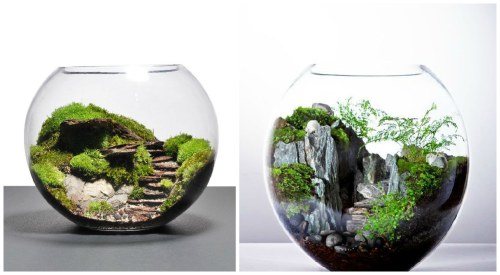

Mountains are a favorite theme of phytodesigners. What could be more picturesque than rocks with green spaces? The large list of plants that can be used to create imitation also attracts:
- dwarf ivy,
- indoor fern,
- saxifrage,
- asparagus and others.
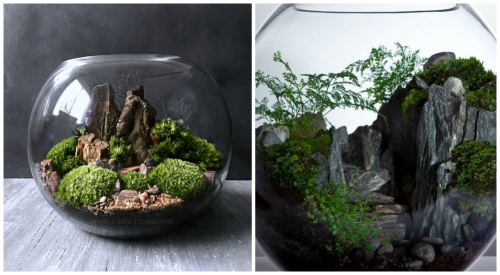

The requirements are the same:
- Achieve complete compatibility of soil and plants.
- The level of humidity, lighting, temperature should fully correspond to the type of landscape.
- Plant only low-growing varieties.
- A florarium vase should have a wide throat - this is necessary for good air circulation.
Plants with unusual colored leaves
Fittonia... It is thanks to the unusual color of the leaves that Fittonia is one of the most popular florariums plants. They are rather large (up to 6 cm) oval and all speckled with pink or silvery-white veins. Fittonia is a rainforest native, but loves the flow of fresh air, so it is better to grow it not in a completely sealed container.
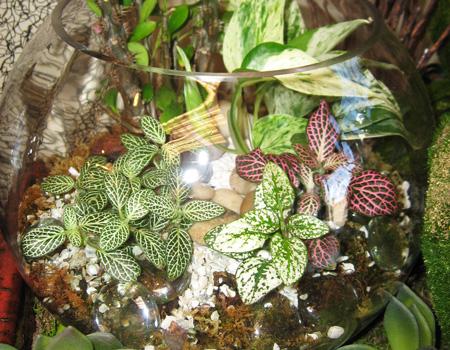

Crotons... Different species and varieties can be very different from each other. Most crotons have large dense dissected leaves, but there are also narrow-leaved species. But on the other hand, all are characterized by a variegated color of leaves. Large and small light golden spots on the leaf blades become more distinct under bright lighting, and with a lack of sunlight, on the contrary, the green color becomes more saturated, sometimes even with a shade of brown and violet.
Alocasia... This plant has very remarkable leaves - an interesting pointed shape with denticles along the edges. Large light veins stand out in relief against a rich dark green background. But the color of the leaves can be reddish or purple. When growing in a pot, it is recommended to immediately remove water from the pan after watering. Therefore, in the florarium, the roots of alocasia should also not touch the water or the drainage layer.
Begonia... To populate the florarium, you should take a closer look at the Rex begonia - a hybrid of the royal begonia, as well as its other medium-sized and dwarf representatives.
Cryptantus... Like gusmania, this is an epiphytic plant from the bromeliad family. Its leafy rosettes look like stars in a wide variety of color shades with bizarre longitudinal and transverse patterns on the leaves themselves. Cryptanthus can be planted directly into the bark or a depression in the driftwood, covering the small roots with sphagnum so as not to dry out.
Of course, it is difficult to list all the plants for the florarium, but you can take a closer look at other plants, for example, ivy, small species of philodendron and ficus, epiprenum. Variegations can be added by using syngoniums, peperomias, dieffenbachia, and decorative bright spots using an episode, which has not only multi-colored leaves, but also bright original flowers. Many Tradescantia leaves are very decorative, they are unpretentious, but in a humid florarium, they can be planted directly into the water. To the place in any composition there will be narrow graceful leaves of asparagus and marsh calamus (cereal). A beautiful rug can cover the substrate not only with moss, but also with soleyroilia or selaginella, which usually cannot be grown in room conditions.
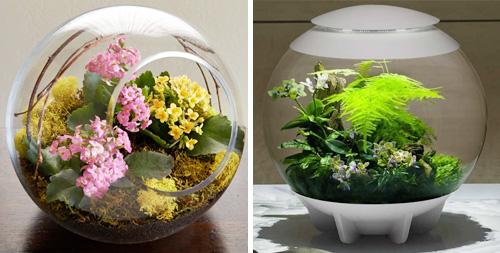

Lovers of special exoticism can be recommended predatory plants - sundew, dionea and sarracenia, growing in southern swamps or flycatchers - from tropical forests. They are very decorative, but occasionally they will have to be fed with live insects.
Floriana with flowers
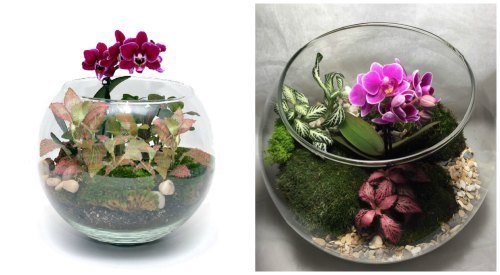

Flower arrangements can be both temporary (with water) and long-term projects - it all depends on the qualities and properties of the flower.
- Orchids. Installations featuring this capricious but wonderful inhabitant of the subtropics are singled out in a separate group. Prestigious orchidariums require painstaking work and tireless care to ensure a comfortable microclimate.
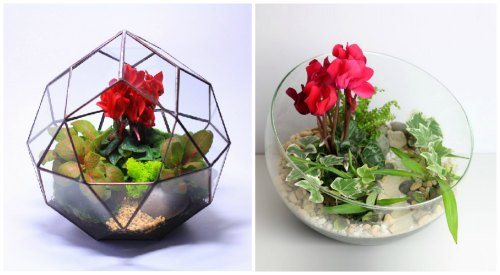

- Cyclamens. The butterfly flower is grown both independently and in combination with alocasia or fern. It is quite difficult to achieve ideal conditions in a glass container for the delicate creation that cyclamen has always been. But it is even more difficult to maintain these conditions in proper condition.
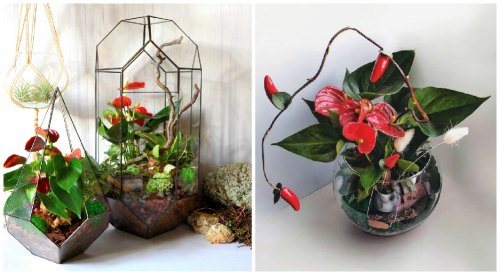

- Anthurium, like no other, is suitable for a mini-greenhouse. Bright flowers fill the entire space and create a magnificent three-dimensional picture. Naturally, we are talking about dwarf hybrids. However, regular varieties also perform well in the long run.
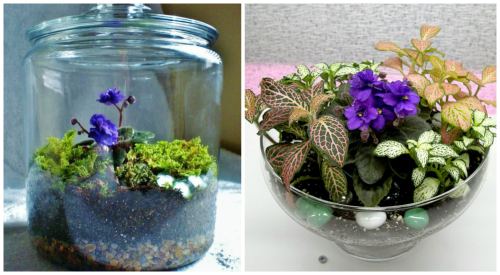

- Violets are good both in closed mini florariums and in open ones. If the flower is provided with comfortable conditions and care, it pleases for a long time with its flowering.
Closed micro-greenhouse
Plants for a florarium of this type are in a closed space under glass and do not need watering. Thanks to the closed environment with its own microclimate, it becomes possible to grow rare and exotic plants in any type of premises. Removing fallen leaves and pinching the tips of the grown plants are all care procedures that are performed as needed.
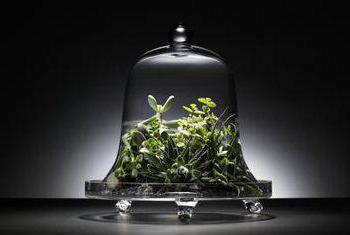

In a closed floraria, plants for respiration independently produce carbon dioxide and oxygen. Such a florarium should be hermetically sealed with a lid and not have any holes. For the purpose of airing, large-scale floraria are equipped with a ventilation system. For small closed florariums (a vase with a lid, a bottle), ventilation is not required. Such micro-greenhouses must be protected from direct sunlight so that the plants do not die from the high temperature inside the bottle. Plants in a buried florarium do not require watering, as they have enough moisture.
What flora representatives can decorate an indoor florarium? Plants from which you can create great compositions in it:
- asplenium;
- begonia (variety with small leaves);
- calathea;
- cryptantus;
- peperomia;
- selaginella.
Instructions for creating a florarium
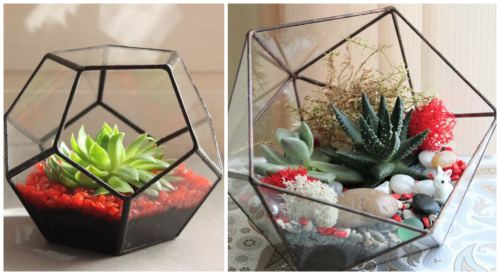

We offer a master class on the example of succulents. We will plant Echeveria, Crassula and Hawortia - the most unpretentious creatures. The installation is suitable not only for home decor, but also for office space decoration.
Step-by-step instructions for creating a florarium:
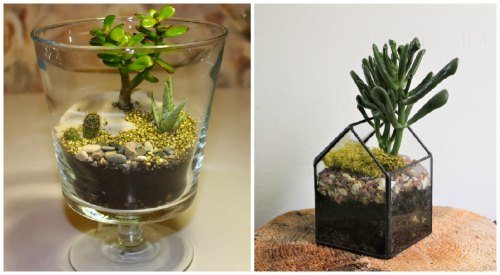

- We carefully free the roots of the purchased succulents from the shipping container and soil.To do this, we slightly crumple the flower pot between the palms and shake off the earth.
- The manufacture of the florarium begins with the preparation of the container. The container can be anything: glass, ceramic, even metal or wood. The main thing is that the bottom is covered with bio-mica or covering material - this will protect it from rust or decay.
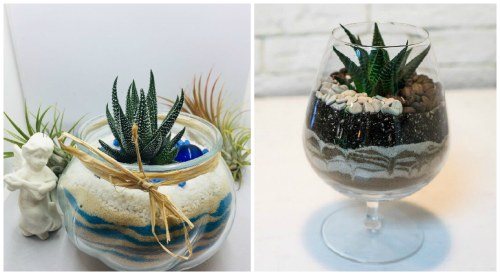

- We form a drainage layer. As drainage, you can use volcanic zeolite - the material with the most versatile characteristics.
- We arrange succulents in a planned order, leaving room for decor elements. When planting, take into account the factor of the subsequent growth of the seedling.
- We fill up the roots with a specialized soil mixture. The ideal solution is a ready-made primer purchased from a flower shop.
- Lightly trample the root space and spill it with water at room temperature. Try to avoid waterlogging: for each root - no more than a tablespoon of water. More will cause rotting. The larger the shape of the container, the stronger the moisture, but not more than 20 milliliters.
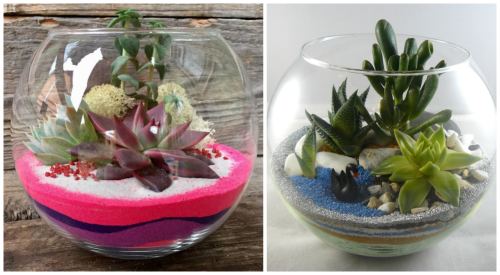

- We decorate it with driftwood, natural or artificial moss, pebbles, multi-colored crystals.
Remember that succulents love light. Choose a location with adequate lighting. Watering frequency is determined by the level of humidity in the room, but not more often than once every two weeks.
Do-it-yourself florarium from an aquarium: master class
As you already know, you can use a wide variety of vessels for making your own home mini-greenhouse. To do this, you can simply thoroughly "scour" your own mezzanines or balcony in search of a suitable container.
If you cannot find such a vessel, use a regular aquarium, which can be purchased new or use an already used vessel.
How to make a florarium with your own hands? Follow the advice of the masters and you will succeed.
Choosing a place for a florarium
Before composing the composition, think over its further location. First, it must be visible so that guests can admire it. Secondly, it must be combined with your chosen interior.
If you are planning a large greenhouse, think over the arrangement of flowers in accordance with the design - in shades, sizes and other additional decorations.
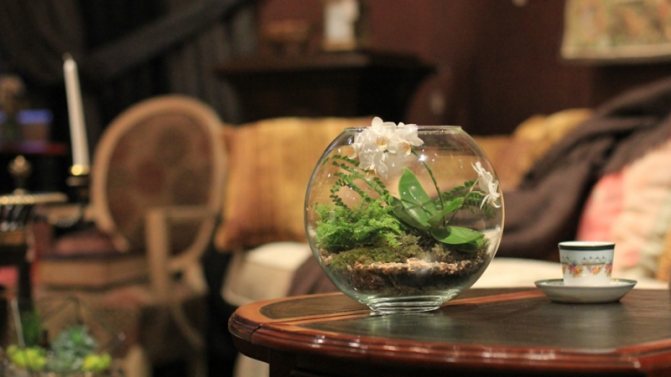

Materials and tools used
To make a florarium, you will need materials that will only fit the flight of your imagination. But as the main details, the following can be distinguished:
- drainage - they put it on the bottom, use various bulk products (river sand, painted decorative sand, broken brick, etc.);
- suitable soil - depends on the type of plants used;
- sphagnum moss or any other type of plant for moisture retention;
- decor for surface - pebbles, bugles and other loose components;
- decoration - it all depends on your imagination, figurines of animals, people, mini-furniture and other attributes will do.
Together with the collection of materials, it is necessary to select the tools that will be required in the work. Here you will need gloves, tweezers of distinctive sizes, a syringe for further watering or a watering can, a spray bottle to wet each layer of soil, any item for digging.
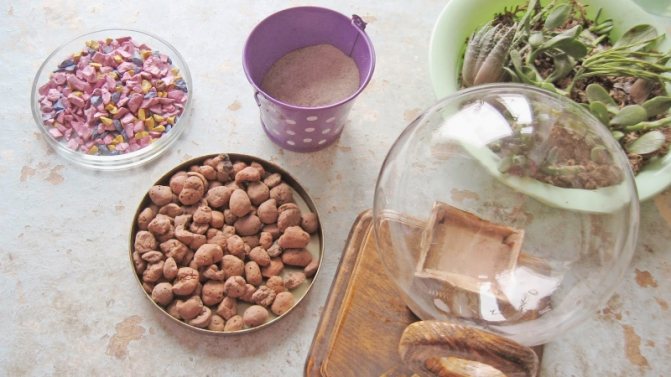

DIY workshop on making a florarium
When making your own florarium, follow the sequence in execution:
- Rinse and dry the selected greenhouse container.
- Place a small layer of drainage on the bottom of the vessel, moisten it with water.
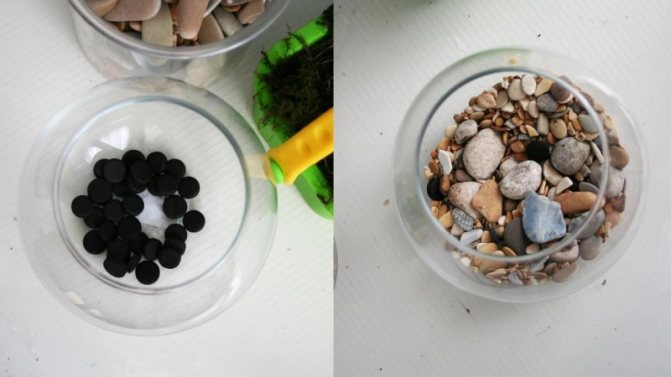

- Pour out soil for planting plants. You can add any additives to the soil as a plant nutrition, but only those species that are suitable for the varieties and species you have chosen.
- Prepare the plants - remove any yellowed leaves and clean them of dirt and other debris.
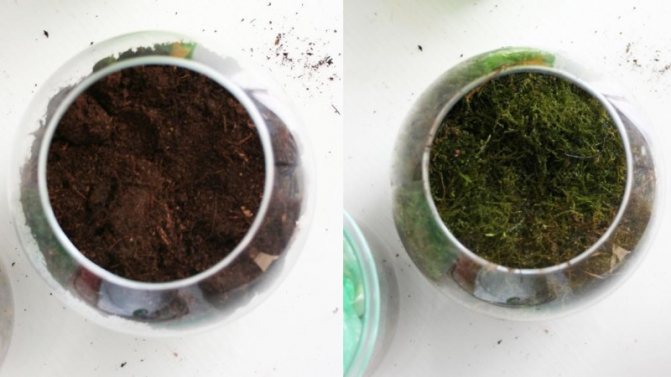

- Use tweezers or fingers to plant the prepared flowers as you originally intended.Do not forget about the location of the moss or other plant species. You can dig up the soil for planting with a teaspoon, chopstick, toothpicks. Sprinkle each plant with soil and tamp lightly.
- Moisten the soil with water from a spray bottle. Water the newly planted plants with a watering can or syringe if necessary.
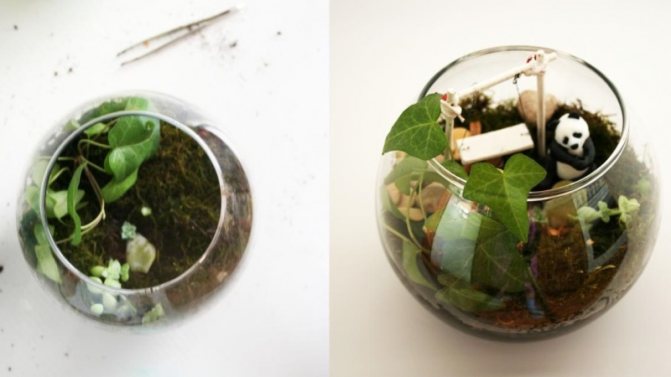

- Use a decorative layer. It can be placed on the entire surface, it can only be in parts - stick to the original plan.
- Arrange other decorative items as desired. If necessary, secure them with the same decorative pebbles or bugles.
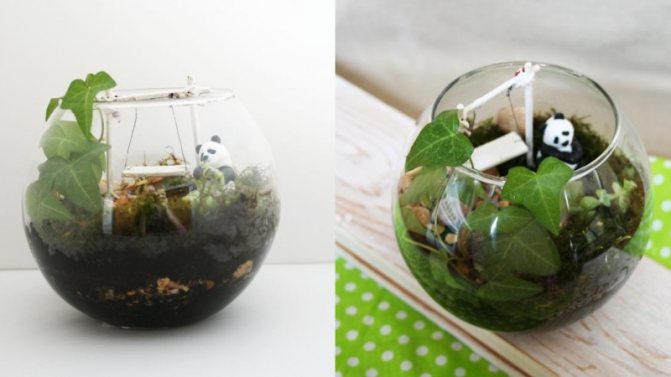

That's it, the florarium is ready with your own hands. Now it is only necessary to monitor him in compliance with all the rules.
Finished greenhouses are often watered from a syringe so as not to spoil the appearance. This is not done so often, because in a closed vessel the humidity is kept at an acceptable level, which allows the plants to be watered once a week or less. Monitor the metrics for additional attributes.
Florariums with bonsai tree
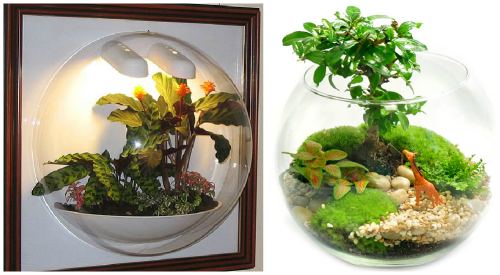

Bonsai Landscape is one of the most stylish and prestigious installations, akin to art. The cost of individual copies, especially wall works, reaches 250 €.
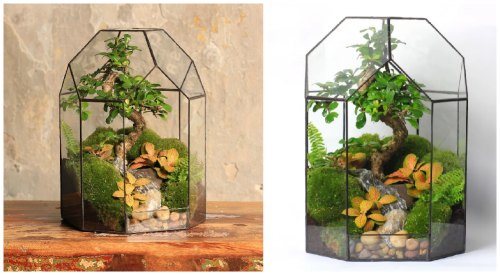

The most spectacular idea is a tree in a closed geometric florarium. However, phytomaster believe: a microcosm formed in an airtight vessel is so vulnerable that a decrease in temperature by only 2-3 degrees will be fatal for roots and leaves.

